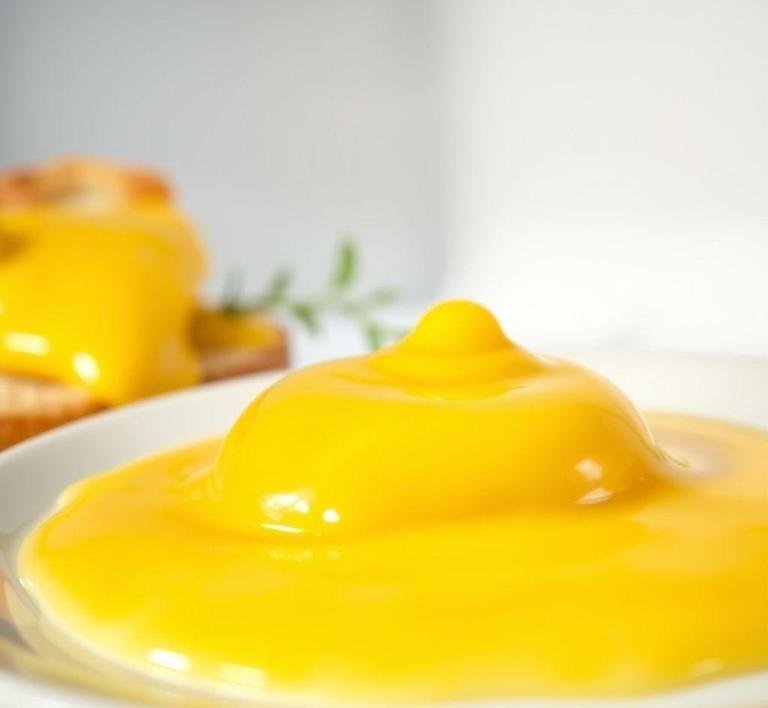Jamie Oliver’s Hollandaise Sauce is a creamy, tangy and buttery classic. It’s one of the five French mother sauces, often paired with eggs Benedict, steamed asparagus or even fish. What makes Jamie’s version stand out is how he simplifies the process while still maintaining a rich flavor and smooth texture. No fancy techniques here. just good ingredients and the right approach.
The sauce has a silky smoothness from the eggs and butter, with a slight zing from lemon juice or vinegar. It’s luxurious, yet not too difficult to master once you know the steps. Jamie’s recipe is all about creating that perfect balance of richness and brightness.
Jamie Oliver Hollandaise Sauce Recipe
Ingredients Needed
You don’t need a long list of exotic ingredients but the ones you do use matter. Here’s what you’ll need for Jamie Oliver’s Hollandaise:
- Egg yolks (about 4): These are the base of your sauce. They give it that velvety texture and rich flavor. Make sure they’re fresh.
- Unsalted butter (around 200g): The butter gives the sauce its silky richness. Jamie opts for unsalted which lets you control the seasoning.
- Lemon juice (freshly squeezed, about 1-2 tbsp): Adds the necessary acidity that cuts through the richness of the butter and eggs. You could also use white wine vinegar but lemon’s freshness is key.
- Salt and pepper: For seasoning. Not too much-just enough to bring everything together.
That’s it! You don’t need anything too fancy, just quality ingredients that’ll really shine when combined.
Equipment Needed
You don’t need any fancy equipment but there are a couple of essentials that’ll make your life a lot easier:
- Whisk: A good old-fashioned whisk will help you emulsify the egg yolks and butter into a smooth sauce. Don’t go for a flimsy one; a sturdy, medium-sized whisk will do the job best.
- Saucepan: You need a saucepan to melt the butter. It doesn’t need to be huge, just big enough to hold the butter and let it melt gently.
- Heatproof bowl: For whisking the egg yolks. Make sure it’s big enough to sit over the saucepan without touching the water (you’ll create a makeshift double boiler).
- Small pan or pot (for a double boiler): Jamie suggests using a double boiler method for gently heating the egg yolks without scrambling them. If you don’t have one, you can create a makeshift double boiler by putting a bowl over a saucepan of simmering water.
That’s the full list! Nothing too complicated, just a couple of key tools to get it done right.
How To Make Jamie Oliver’s Hollandaise Sauce
Making Hollandaise might sound intimidating but trust me-it’s easier than you think, especially with Jamie’s step-by-step guide.
- Melt the Butter: Start by melting the butter in a small saucepan over low heat. You want it to melt slowly, not sizzle. Once it’s melted, set it aside to cool slightly.
- Prepare the Egg Yolks: In your heatproof bowl, whisk together the egg yolks and a little bit of lemon juice or vinegar. The acid helps the yolks emulsify with the butter.
- Create the Double Boiler: Bring a pot of water to a simmer and place your bowl with the egg yolks over the pan. You don’t want the water to touch the bowl, just enough steam to heat the yolks gently.
- Whisk, Whisk, Whisk: Now the key is to whisk constantly while the yolks are heating. You’re looking for the yolks to become pale and thick. This could take about 2 minutes, so be patient and keep whisking. You don’t want them to scramble!
- Add the Butter: Slowly and I mean slowly, pour in the melted butter while whisking continuously. Start with a small drizzle and as the sauce begins to emulsify, you can add the butter more quickly. The key is to incorporate it gradually, so the sauce stays smooth.
- Season: Once all the butter is incorporated, taste your sauce. Add salt, pepper and extra lemon juice to taste. Keep whisking until it’s perfectly smooth and glossy.
- Serve: Your Hollandaise should be thick but still pourable. Serve it immediately or keep it warm by placing the bowl in a warm spot (just not over direct heat or it might curdle).
What I Learnt

Making Jamie Oliver’s Hollandaise sauce was a revelation. First of all, I was surprised at how simple the process actually is. especially considering how fancy the sauce sounds. The key, I realized, was in the gentle temperature control and whisking. If you rush through it or use too high a heat, you’re more likely to end up with scrambled eggs instead of a smooth, velvety sauce.
Another thing I learned is the importance of the butter. It’s not just about melting it. it’s about adding it at the right speed to ensure it emulsifies properly with the egg yolks. That slow addition is what creates the beautiful texture.
I also got how much you can personalize it with seasoning. Just a little extra lemon juice or vinegar can totally change the sauce’s character.
Recipe Tweaks For Jamie Oliver’s Hollandaise Sauce
Jamie Oliver’s Hollandaise sauce is already a winning recipe but there’s always room to make it your own. Here are some tweaks to try.
-
Lemon vs. Vinegar
The traditional recipe calls for lemon juice but if you want a bit more depth or a sharp contrast, try swapping it for white wine vinegar or apple cider vinegar. The acidity of vinegar cuts through the richness of the butter in a different way than lemon, making it a little more zesty.
-
Herb Infusion
Jamie’s recipe is simple but why not infuse your butter with herbs? A rosemary or thyme sprig in the butter as it melts adds subtle, aromatic flavors that elevate the sauce. Just be sure to strain the herbs out before combining it with the egg yolks.
-
Spicy Kick
If you’re into heat, add a pinch of cayenne pepper or a few dashes of Tabasco sauce. It’ll add a beautiful warmth without overpowering the sauce’s buttery flavor.
-
Smoked Flavor
A teaspoon of smoked paprika can bring a nice smoky twist to the sauce. It gives a layer of complexity, perfect for pairing with grilled meats or seafood.
-
Garlic
A small crushed garlic clove (infused into the butter before using it) can bring a savory depth to the sauce. Be careful, though-garlic’s flavor can quickly dominate, so go easy on it.
-
Dijon Mustard
A touch of Dijon mustard, not just for flavor but it also helps stabilize the sauce. It gives the Hollandaise an extra creamy texture and a bit of sharpness.
Storage Tips For Leftovers
Hollandaise sauce doesn’t have the best shelf life because of its delicate ingredients but you can extend its usability with a few tricks.
-
Refrigerating
Leftover Hollandaise should be kept in an airtight container and refrigerated immediately. The sauce typically lasts about 1-2 days in the fridge. Just be mindful that it can separate, so you’ll need to whisk it back together gently when reheating.
-
Reheating
Don’t use high heat when reheating Hollandaise. The key is to gently warm it over a double boiler (or a bowl over simmering water) and whisk constantly. If it starts to split, you can add a few drops of warm water or a teaspoon of fresh lemon juice to bring it back together.
-
Freezing (Not Ideal, But Possible)
If you have a lot of leftover sauce, you can freeze it but keep in mind the texture might change. Freeze it in small portions in ice cube trays, then transfer them to a sealed bag. When you thaw it, it may separate, so again, whisking will be essential.
What To Eat With Jamie Oliver’s Hollandaise Sauce?
Hollandaise is like the queen of sauces. it’s buttery, tangy and luxurious. There are so many ways to enjoy it, from classic to unexpected pairings.
-
Classic Eggs Benedict
The obvious choice. Poached eggs, crispy bacon or ham and an English muffin, all smothered in that silky Hollandaise. It’s the brunch dream, isn’t it?
-
Asparagus
This pairing is timeless. The richness of Hollandaise complements the slight bitterness of asparagus perfectly. Lightly steamed or blanched, the asparagus provides a fresh contrast to the sauce’s velvety texture.
-
Grilled Fish
White fish, salmon or even grilled shellfish like shrimp or lobster go beautifully with Hollandaise. The sauce adds richness to the lightness of fish without overwhelming it.
-
Roasted Vegetables
Roasted cauliflower, Brussels sprouts or even roasted potatoes-anything with a bit of char works wonderfully with this creamy sauce. Hollandaise helps round out the flavors, making the vegetables taste even more indulgent.
-
Steak or Grilled Meats
It might sound unconventional but Hollandaise is delicious with grilled steak or roast lamb. The sauce cuts through the richness of the meat and adds a tangy balance that enhances the flavor.
-
Breakfast Foods
Hollandaise isn’t just for fancy brunches. Pour it over scrambled eggs or an omelet for a decadent breakfast experience. It also works well on potato hash or roasted tomatoes for a savory start to your day.
-
Pizza?
This is a fun one. think of a white pizza topped with spinach, mushrooms and maybe some chicken or bacon. Drizzle a little Hollandaise on top for a creamy, rich twist.
FAQs
What Ingredients Do I Need For Jamie Oliver’s Hollandaise Sauce?
You’ll need butter, egg yolks, lemon juice, mustard, and seasoning like salt and pepper.
Can I Make Jamie Oliver’s Hollandaise Sauce Ahead Of Time?
It’s best made fresh, but you can keep it warm in a bowl over hot water for a short while. Just make sure to stir occasionally.
Why Did My Hollandaise Sauce Split?
This usually happens if the butter’s added too quickly or the sauce gets too hot. Try adding the butter slowly and keep the temperature low.


